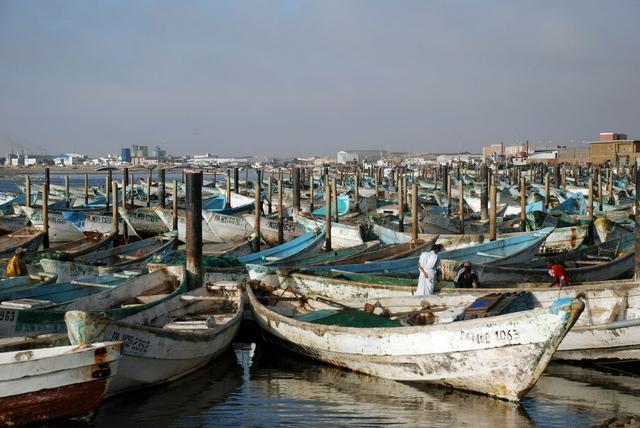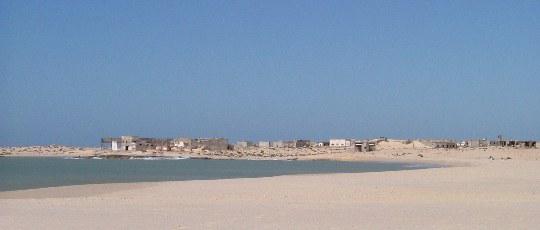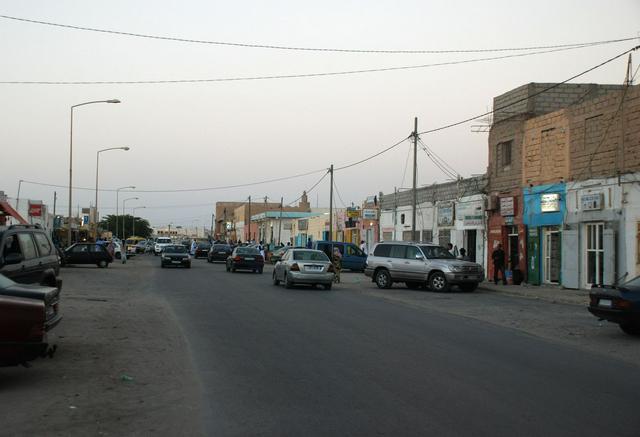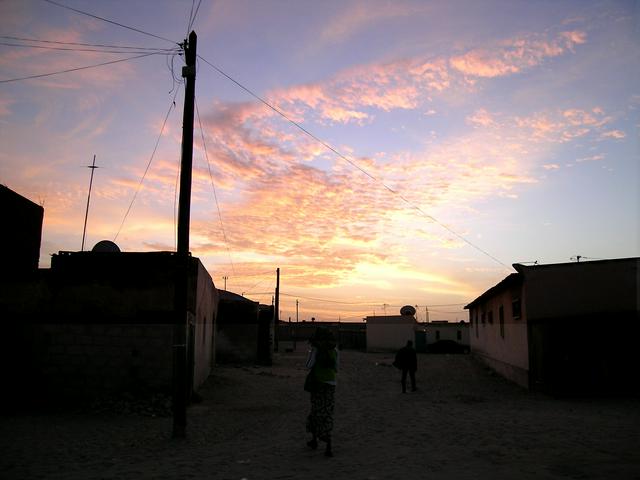Nouadhibou is the second largest city in Mauritania. It's a major fishing centre and large industrial port.
 A key economic centre, it's home to roughly 90,000 people. Before independence, the town was called Port Etienne by the French colonists after the first boat which arrived here, the Tienne. Since independence in 1960, it has been called Nouadhibou, which means Place of the Jackal. Many jackals used to come and drink water in a well. The town's three main parts are:
A key economic centre, it's home to roughly 90,000 people. Before independence, the town was called Port Etienne by the French colonists after the first boat which arrived here, the Tienne. Since independence in 1960, it has been called Nouadhibou, which means Place of the Jackal. Many jackals used to come and drink water in a well. The town's three main parts are:
- Cansado: Means tired in Spanish. This area is about 10 km from Keran. It was built by the French in 1960, for the workers of the SNIM mining company. It has a nice hotel, tennis courts and petanque grounds.
- Keran: The town centre was built in 1958. The central police, customs, banks, office supply and central market are here.
- Numerowatt: Starts with the area of Socogim and is divided into 6 water taps (French: robinets). It was built in 1982-83. The water comes from an underground lake in Boulenoir, about 90 km from here. The pipes were laid in 1960. The town has developed quite recently and is growing rapidly. Most of the town lives here.
In 1990, the tarmac from Keran to Numerwatt was built - a distance of about 13 km. In 2000, The town centre roads were paved and Internet and mobile phones arrived.
In 2005, the highway between Nouadhibou and Nouakchott was completed. There is now a clean half-way stop at the 235 km mark built by a Moroccan business where you can get a fresh cup of coffee and tasty sandwiches as well as a tajine, a kind of meat stew. They also have separate toilets for men and women as well as a simple tyre changing shop. Nearby is the entrance to the Banc d'Arguin national park.
Nouadhibou without SNIM or fishing would not be the same. SNIM, the Société Nationale Industrielle et Minière, is the biggest company in Mauritania. The iron began being mined in the 1960s when they began building the railway which carries one of the longest trains in the world (2 km). Passengers can pay to sit inside a rail car or ride for free on top, which is quite the ride.
The other economic engine is the fishing industry. There are 3 ports: a commercial port (Port Autonome), a local fishing port (Port Artisanal) and the private SNIM port at Cansado for iron export. If you like salty air, sea food and fish, checking out the Port Artisanal can be a treat.
Cansado: Means tired in Spanish. This area is about 10 km from Keran. It was built by the French in 1960, for the workers of the SNIM mining company. It has a nice hotel, tennis courts and petanque grounds.
Keran: The town centre was built in 1958. The central police, customs, banks, office supply and central market are here.
Numerowatt: Starts with the area of Socogim and is divided into 6 water taps (French: robinets). It was built in 1982-83. The water comes from an underground lake in Boulenoir, about 90 km from here. The pipes were laid in 1960. The town has developed quite recently and is growing rapidly. Most of the town lives here.


- Fishing harbour with Senegalese boats. Also, there are many shipwrecks in the Nouadhibou Bay. The biggest and most recent shipwreck lies at the tip of the peninsula.
- At the absolute southernmost tip of the same peninsula, there is a small national park, where for a small fee you can observe the meeting point between the bay and the Atlantic Ocean. The point is home to several monk seals. Some of them have been aggressive, so keep a safe distance.
- Between the Port Autonome and Cansado are the ruins of an old French coastal gun emplacement designed in its day to protect the French colony from the Spanish border a few kilometres away. There is no fee and no guide. There are underground tunnels which connect the 15 meter high gun towers. Some tunnels drop off dangerously! A torch or flashlight is helpful.
- You might be tempted to visit the old Spanish buildings at the little town of La Guera on the southern peninsula. It's not actually in Mauritania, but a disputed territory just to the west of Mauritania, so exploring the historic site technically requires an official border crossing. There is now a Mauritanian military post nearby. If interested, check with local authorities first.
- The down town market, in Keran, behind the main middle road, is full of little shops selling a surprising variety of things from all over the world. It has a well stocked chep-chep or second-hand market. You can find prizes for next to nothing.
At the absolute southernmost tip of the same peninsula, there is a small national park, where for a small fee you can observe the meeting point between the bay and the Atlantic Ocean. The point is home to several monk seals. Some of them have been aggressive, so keep a safe distance.
Between the Port Autonome and Cansado are the ruins of an old French coastal gun emplacement designed in its day to protect the French colony from the Spanish border a few kilometres away. There is no fee and no guide. There are underground tunnels which connect the 15 meter high gun towers. Some tunnels drop off dangerously! A torch or flashlight is helpful.
You might be tempted to visit the old Spanish buildings at the little town of La Guera on the southern peninsula. It's not actually in Mauritania, but a [[Western Sahara|disputed territory]] just to the west of Mauritania, so exploring the historic site technically requires an official border crossing. There is now a Mauritanian military post nearby. If interested, check with local authorities first.
The down town market, in Keran, behind the main middle road, is full of little shops selling a surprising variety of things from all over the world. It has a well stocked chep-chep or second-hand market. You can find prizes for next to nothing.
-prPKJ.medium.jpg)
- Bird watchers can visit the salt marsh estuary next to the bay. It will be on the left as one heads towards the Centre de Pêche. There is occasionally a police check point at the green shipping container on the way there.
- Fishing for sea trout with spoons or squid can be exciting on the bay. There is a pier at the Centre de Pêche. Look for higher tides for better results. The hotel has a couple of boats to either take people out fishing (you can rent fishing gear as well) or to ferry small groups to a picnic island on the far side of the bay. There is a small cabin structure to shelter you from the often intense sun. Many pelicans and other large sea birds sun themselves on this sandy stretch. The centre has a restaurant with a children's playground. They serve a fresh grilled sea trout and local tea (Arabic: Ataya).
- Those with kiteboards can take advantage of the steady brisk winds wafting across Nouadhibou bay virtually year round. The bay extends almost 20 kilometres from its northern tip to the Ras Nouadhibou. The shallower small craft portion is much smaller, about 10 km wide. Often the water is only a few meters or less in depth, clear and temperate. Online weather services can provide daily tide and wind details.
- If you have your own fishing equipment and four wheel drive, there are several places to fish on the very southern tip of the peninsula, known as Cap Blanc, to the right of the SNIM port/refinery facilities. It's wise to go with a local friend as there can be security check points, it's a fairly remote spot and is extremely close to the Moroccan border. Long traces having 2 or more hooks with a heavy lead weight are best for surf cast fishing. If you have a boat, there are Southern Meager (French: Corbine) to be had in deeper waters. They can reach 50 kg.
- For young sporting types, there are informal and formal football matches in an indoor size format at the Club Sahel. It's on the lower road not far from the Casa Canaria restaurant. There is a fee or just enjoy the great play. Most matches begin in the late afternoon and early evening well into the night.
- Spend a relaxing afternoon reading a novel or catching up on the latest news at the Alliance Franco Mauritanienne. They have gardens and trees, a rarity in Nouadhibou. It's behind the Central Bank, which is in front of the Governor's (Arabic: Waly) offices. Most of their material is in French. Their telephone is +222 574 58 71.
Bird watchers can visit the salt marsh estuary next to the bay. It will be on the left as one heads towards the Centre de Pêche. There is occasionally a police check point at the green shipping container on the way there.
Fishing for sea trout with spoons or squid can be exciting on the bay. There is a pier at the Centre de Pêche. Look for higher tides for better results. The hotel has a couple of boats to either take people out fishing (you can rent fishing gear as well) or to ferry small groups to a picnic island on the far side of the bay. There is a small cabin structure to shelter you from the often intense sun. Many pelicans and other large sea birds sun themselves on this sandy stretch. The centre has a restaurant with a children's playground. They serve a fresh grilled sea trout and local tea (Arabic: Ataya).
Those with kiteboards can take advantage of the steady brisk winds wafting across Nouadhibou bay virtually year round. The bay extends almost 20 kilometres from its northern tip to the Ras Nouadhibou. The shallower small craft portion is much smaller, about 10 km wide. Often the water is only a few meters or less in depth, clear and temperate. Online weather services can provide daily tide and wind details.
If you have your own fishing equipment and four wheel drive, there are several places to fish on the very southern tip of the peninsula, known as Cap Blanc, to the right of the SNIM port/refinery facilities. It's wise to go with a local friend as there can be security check points, it's a fairly remote spot and is extremely close to the Moroccan border. Long traces having 2 or more hooks with a heavy lead weight are best for surf cast fishing. If you have a boat, there are Southern Meager (French: Corbine) to be had in deeper waters. They can reach 50 kg.
For young sporting types, there are informal and formal football matches in an indoor size format at the Club Sahel. It's on the lower road not far from the Casa Canaria restaurant. There is a fee or just enjoy the great play. Most matches begin in the late afternoon and early evening well into the night.
Spend a relaxing afternoon reading a novel or catching up on the latest news at the Alliance Franco Mauritanienne. They have gardens and trees, a rarity in Nouadhibou. It's behind the Central Bank, which is in front of the Governor's (Arabic: Waly) offices. Most of their material is in French. Their telephone is +222 574 58 71.
 The four largest supermarkets are:
The four largest supermarkets are:
- Carrefour, at the first intersection of the city centre.
- Bon Marché
- 28 Novembre
- the Cansado grocery store.
The first three stores are on the main street within 200 metres of each other. Bon Marché and 28 Novembre face each other. You can find most things including cheese and toiletries. Prices are sometimes a bit expensive. Local corner grocery stores, good épiceries, may have everything you need. The market carries fresh vegetables as well as meat and fish. Staples, such as sugar, rice, milk, bread, yoghurt, bug spray, toilet paper, bleach and soap powder can be found in your local corner shop or boutique. Hamburger meat, and beef fillet can be found at the Tunisian butcher across the street from 28th Novembre.
Several banks in town have ATMs that accept foreign cards. Société generale bank Atms take Mastercard /visa card. There's a decent Forex or bureau de change at the entrance to Keran, the town centre, at the Carrefour crossroads. Ask for a receipt to avoid any problems crossing the borders next time you cross. They will photocopy your passport along with the receipt. Officially, you should leave your local ougiyas currency in Mauritania and not take them out with you. Smaller amounts usually aren't a problem.
Should you need help with your vehicle, look for El-Veteh Siddaty et Freres, a well known car parts store in Keran. Their manager speaks English and French and can help you find specialised mechanics such as for electrical problems. Their telephone is +222 574 5739. There are many other similar shops nearby.
As Nouadhibou has a big commercial fishing and traditional fishing port, there is a lot of fresh seafood and fish available. Many immigrants from Senegal have restaurants here, serving fish with rice and other delicious meals. Average price is 200-500 ougiyas. If you like Chinese food, there are several restaurants on the lower road, which cater to foreigners.
For football, the FC Nouadhibou restaurant serves hamburgers, French fries and other hot sandwiches in front of several large TV screens. It's between the second and third robinets on the middle road.
- Casa Canaria. A Spanish restaurant
- La Paillotte, 212, Blvd Maritime, +222 45743218. One of the current hot spots to eat out is this Italian restaurant, which has a new Spanish chef- Entrees from 2,000 ougiyas.
- Madame Souware's, 3, Robinet. Lunch betweeen 1:30PM - 3PM. Fine example of a Senegalese restaurant serving up excellent seafood. A plate is 250 ougiyas.
- Nomada. Serving European cuisine
- Pleine de Lune. Serves small snacks, cakes, pastries, mini pizzas, meat rolls and sandwiches. A chicken sandwich is 700 ougiyas.
Casa Canaria. A Spanish restaurant
La Paillotte, 212, Blvd Maritime, +222 45743218. One of the current hot spots to eat out is this Italian restaurant, which has a new Spanish chef- Entrees from 2,000 ougiyas.
Madame Souware's, 3, Robinet. Lunch betweeen 1:30PM - 3PM. Fine example of a Senegalese restaurant serving up excellent seafood. A plate is 250 ougiyas.
Nomada. Serving European cuisine
Pleine de Lune. Serves small snacks, cakes, pastries, mini pizzas, meat rolls and sandwiches. A chicken sandwich is 700 ougiyas.
- Fresh camel milk. At the entrance to town where large camel herds are gathered. Herders often sell fresh milk close to evening time. It's amazingly refreshing on a hot day.
 Nouadhibou is a relatively safe city, but there are almost no street lights. Remember to take a torch when going out in the evening.
Nouadhibou is a relatively safe city, but there are almost no street lights. Remember to take a torch when going out in the evening.
The biggest danger is undisciplined road traffic. Be careful, especially in the central area.
Do not cross the train tracks as many areas, even fairly close to the town centre, have not yet been entirely cleared of mines. Only surfaced roads past the tracks are absolutely safe. If you must cross the tracks, or do so with a trusted friend who knows the area or with a local authority.
Women generally stay indoors after dark. Going about town in groups is wise for both men and women. Local women are usually escorted by their male relatives at night. During the day, a woman will go about with at least a younger boy or another female friend. It's unusual to find a woman travelling by herself. As in any modern city, stay in places that have night security personnel and lockable doors and windows.
Parts of the town also has a reputation for prostitution, which is illegal in Mauritania.
Flying out by plane, your own vehicle in the day (along with other cars recommended) or on one of the nationally run bus lines are all excellent options. If you need professional travel services, there are several good ones in the central area.
- Bon Voyage Travel are pleasant and know what local transport options are available. Their phone is +222 574 6180. Look for them a few shops down from the 28 Novembre supermarket.
Bon Voyage Travel are pleasant and know what local transport options are available. Their phone is +222 574 6180. Look for them a few shops down from the 28 Novembre supermarket.
